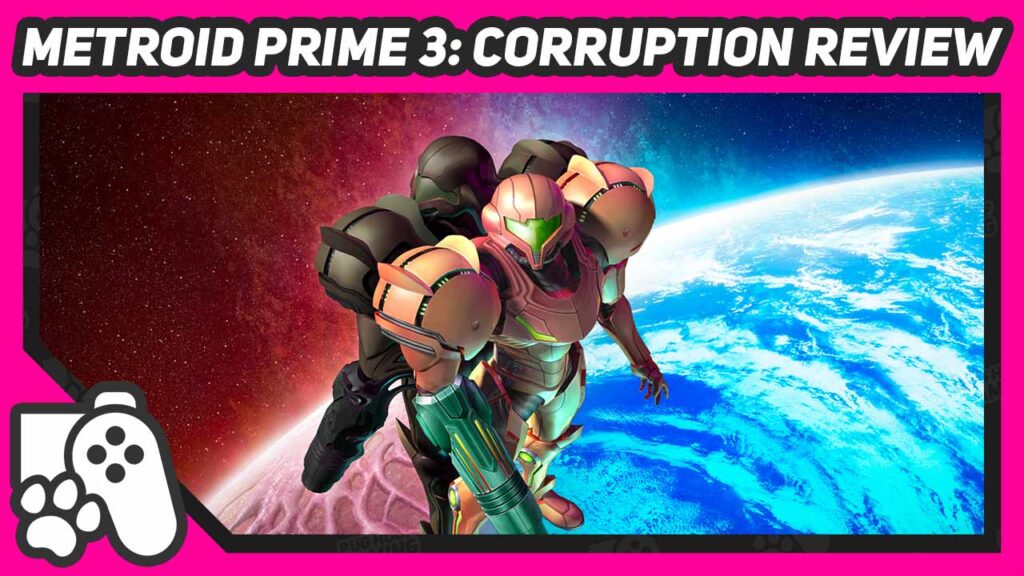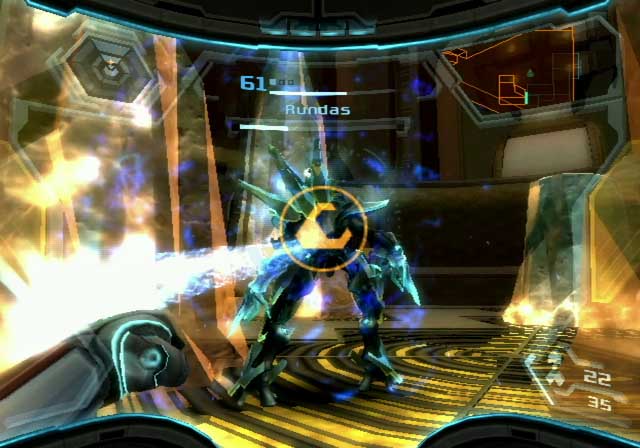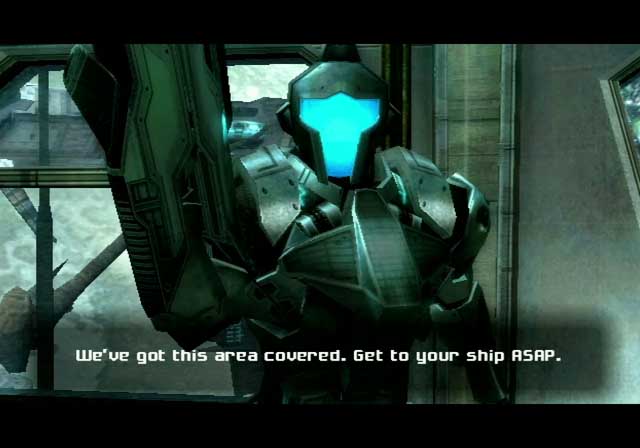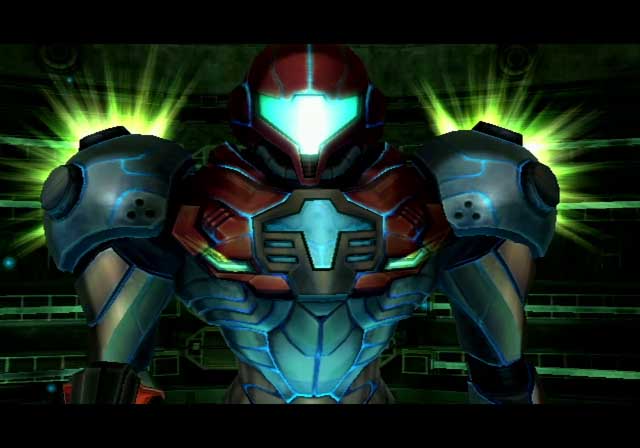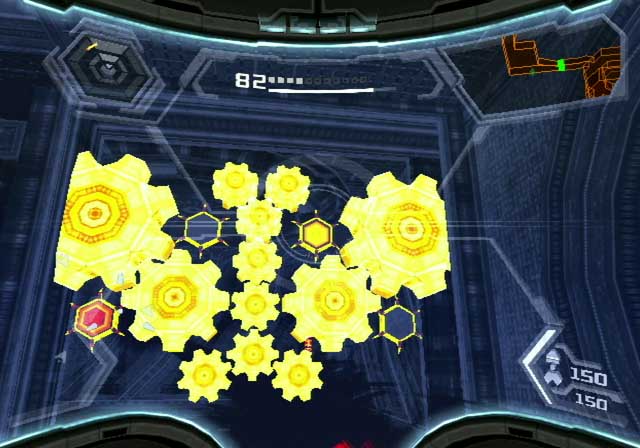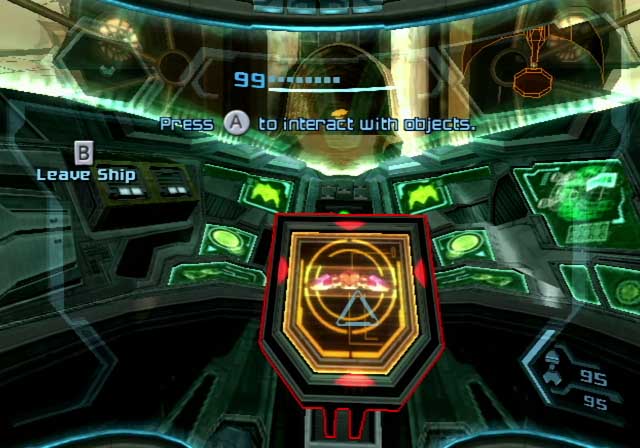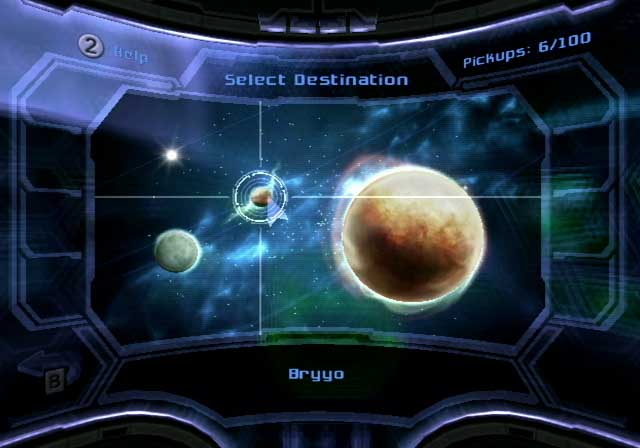It’s 2007, and things are looking pretty damn rosy for Nintendo. To say that the Wii’s 2006 launch was successful is arguably the understatement of the decade, and the Nintendo DS was also hitting its stride. For the first time in a long time, Nintendo were absolutely ruling both the console and handheld markets. Even better for us Metroid fans, we were riding high on a wave that saw more games in the series than we knew what to do with, and the Prime series was the crown jewel in Samus’ renaissance.
Naturally, the series would continue on Nintendo’s newest system, giving us Metroid Prime 3: Corruption. Retro Studios would once again deliver a first-person adventure in the vein of its two prior titles, whilst also providing closure to the Dark Samus saga.
Metroid Prime 3: Corruption Wii Review – The Plot
This new adventure has a lot going on, with Samus once again hired by the Galactic Federation to restore peace to the galaxy – Only this time she’s joined by rival Bounty Hunters, some last seen in Metroid Prime: Hunters. A simple mission to eradicate a virus from the Federation’s Aurora Unit AI systems becomes a much more complicated series of events. Dark Samus has grown stronger and has used her Phazon-powered abilities to corrupt the Space Pirates and utilise them for her own ends. Her goal: To send Phazon meteorites called Leviathan Seeds, on a collision course with multiple planets, to corrupt them and take over the galaxy.
An early encounter between the Bounty Hunters, Samus and her horrific doppelganger culminates in catastrophic injuries and our new comrades find themselves corrupted by Dark Samus. Samus survives, uncorrupted but not unchanged as her body is now providing a dangerous level of Phazon radiation – Thankfully kept at bay using an experimental Phazon Enhancement Device that can channel Phazon energy into destructive power, at great risk to the user. Now, our hero must not only find the corrupted Bounty Hunters, but also destroy the Leviathan seeds and halt Dark Samus’ plan before the galaxy is enslaved – All while trying not to succumb to the corruptive nature of Phazon.
Metroid Prime 3: Corruption was at the time, intended as the completion of a trilogy, and it really shows as Retro Studios have absolutely pulled the stops out to make this third game the biggest and most impressive title of the three.
A new credit system is implemented here, where actions in-game such as scanning enemies, beating bosses or achieving difficult feats of gaming ability reward you with different coloured credits which are used to unlock concept art and other bonuses. It’s a nice way to encourage players to replay the game (and to get everything, you have to), but some of these credits are ridiculously difficult to get, and in the cases of Green credits – Now impossible to get legitimately as it required the now-defunct Nintendo WiFi Connection, to swap unlocked Friend Vouchers with other people to get Green credits. It was difficult to do back then, and impossible now unless you grab a hacked save game with all the Green credits already unlocked. This credit system was also brought to the other Prime games when the Trilogy collection was released on Wii in 2009.
Built with the Wii’s control scheme in mind, Corruption might be one of the best controlling games on the system, blending accurate shooting controls, with a few, but not too many gimmicky motion controls for manually interacting with things like terminals and levers. There’s a nice balance here, avoiding many of the pitfalls the majority of Wii games fall into, and the result is a game that is enhanced with motion controls, not hindered.
After playing the first two Prime games with motion controls, Corruption is refreshingly simpler to play by comparison. Here, the player only has one Beam weapon to worry about, which is replaced by upgrades found throughout the adventure, and there are only three Visors to worry about too. The Scan visor returns once more, completely intact from its appearance in Echoes – Unfortunately, there are still missable scans, but as the logbook only unlocks Red credits rather than hidden endings; missing scans isn’t such a big issue unless you really want those unlockables. Also returning is the X-Ray Visor, but now in a new and improved form that doesn’t obscure objects, while also highlighting interactive elements in a similar fashion to Prime’s Thermal visor. Finally, the all-new Command Visor is used to remotely instruct Samus’ ship to perform a variety of tasks, from landing to lifting heavy objects and even raining down missiles on enemy targets. Each of these visors serves its purposes in multiple ingenious ways throughout the entirety of the game, and more importantly, don’t hinder the player while they’re used, as in the case of the X-Ray visor in the original Prime.
Whilst Samus only has one beam weapon at her disposal, as always she encounters her trusty missile launcher, plus the Seeker missiles from Echoes return, although they aren’t utilised quite as well here. Early on, Samus’ standard missiles are given an upgrade in the form of the returning Ice Missiles from Metroid Fusion. These chilly explosives are useful for freezing fuel gel to make platforms, or in an offensive capacity to slow down or even freeze weaker enemies. The Grapple Swing returns but is also joined by the Grapple Lasso which is thrown by locking onto an enemy or object and throwing the Nunchuk forward. A satisfying yank of the Nunchuk will then pull the grappled object towards you, an ability used to rip off panels to reveal secrets, or even to take apart enemy defences. Later on, the Grapple Lasso can be given the ability to transfer power, by draining energy to heal yourself, or using your own energy to power terminals.
Another returning item is the Screw Attack, as seen in Echoes. Found much earlier on this time around, it has a much better outing this time around, and can still be used with Wall Jump panels to reach higher areas. The Morph Ball isn’t quite as useful as it was in Echoes, despite the Boost Ball and Spider ball functions returning – It just isn’t as used as much in Corruption, probably a good thing for those who hated the previous game’s Spider Guardian boss.
But Corruption’s biggest new addition is an entirely new mechanic called Hypermode. Thanks to the combination of Samus’ Phazon sickness and her new PED suit, holding the Plus button at any time will expend an entire Energy Tank and place the player in Hypermode, upgrading her Power Beam to cause massive amounts of damage to enemies. Firing this new Hyper Beam depletes the Hypermode bar at the top of the screen, after which point the player is taken out of Hypermode. However, if the player spends too long in Hypermode without depleting the bar, or is hit by too many Phazon attacks, they are put in a Corrupted state, where the bar starts to fill and needs to be vented by rapidly firing the Hyper Beam. Failure to vent the bar in time leads to a Game Over state. What’s more, some enemies are able to enter a Hypermode state themselves, making them harder to kill with regular Power Beam shots, but are more susceptible to the Hypermode’s Hyper Beam. As a result, there is a constant risk and reward system in play, with the player having to choose whether to sacrifice health for increased offensive capabilities. As well as the Hyper Beam, Samus also receives Hyper versions of her Missiles, Grapple Lasso and even Morph Ball bombs.
As you can imagine, Hypermode is a massive part of the game, but one that’s easily exploited as it does make many parts of the game far too easy. If you’re played all the Prime games up to this point, I would definitely ramp up the difficulty to Veteran as I had done for this review, as it really does give Corruption much more of a challenge. Hypermode definitely makes this game feel like more of a shooter, but not in such a way that it’s imposing to everything you love about the Prime series. There might be a little more linearity to progression than previous games, but those elements are absolutely still here. The Hint system is way more overbearing than it was before, and even turning off the Hint System in Options doesn’t stop the regular interruptions the player experiences – It just turns off the icon on the map, telling the player where to go next. Every time you start the game, more often than not, you’ll be given explicit instructions on what to do next – Whether you want it or not. The interlinked regions of Prime 1 and 2 are gone, replaced with separate planets for the player to travel between at their leisure, with further places to land Samus’ ship and explore as the story reaches its end.
Speaking of Samus’ ship – It’s a fully realised mechanic in itself, this time around. You’ll be able to enter the cockpit of this infamous Gunship for the first time, and although its various gadgets and doohickeys aren’t utilised enough, it’s quite cool to finally see the inside of this magnificent craft, instead of jumping on top of it all the time.
Backtracking is absolutely still a factor, even if it has been minimalised somewhat – Not a bad thing as it happens, as this time around it definitely feels like you aren’t retreading the same areas over and over again. You’re regularly seeing new things, even in areas you’ve previously visited, and while there is a quest that involves revisiting areas to find a new MacGuffin – Instead of Artefacts and Temple keys, this time it’s Energy Cells that are used in the GFS Valhalla location in order to explore further; it isn’t as tedious as it sounds, and you can even find the majority of them whilst you’re playing the game normally. I had almost failed to mention that the Map system now lets you “Bookmark” rooms on the map, highlighting them green for later exploration. It’s a nice addition, but one I didn’t even know about until after I had finished the game, as neither the manual nor the in-game tutorial tells you about it. Honestly, I wish I had known about it sooner because it would have been particularly useful for finding pickups! Still, now you know about it.
I found Corruption to be the exact length I needed it to be, with very little in the way of padding, while the overall pace is pretty much spot on. It helps that there’s a much more interesting variety of environments here – Even individual planets have a greater level of diversity than the entirety of Echoes. These new locales look gorgeous and all feel unique, helping to keep Corruption a fresh experience even after hours of play.
Whilst there are some returning enemies, thankfully only some designs are reused; and are done in more interesting ways, too. Don’t worry, there are plenty of new enemies to tackle, and the fact that some of them use Hypermode makes them even deadlier. Meanwhile, Corruption doesn’t disappoint in the bosses department, with a new batch of deadly foes, small and large; just ripe for using all of Samus’ new abilities on. Many of them are designed with the new Wii remote pointer controls in mind, requiring some accurate shooting instead of the standard lock-on and strafe gameplay of old, but thankfully the pointer controls still work well. There’s possibly a little too much reliance on using the Grapple Lasso to pull at various enemy appendages and armour, but as mentioned earlier, it’s quite a satisfying mechanic so I forgive Retro Studios in this regard. Especially when they’ve done such a good job at balancing boss difficulty for Corruption.
The attention to detail to Prime’s world and lore is as exquisite as ever. Logbook scans once again help bring extended details to players who want them, and I was surprised to see how much they tied in the events of Primes 1 and 2, as well. Once again, Retro Studios do an excellent job of giving us a glimpse of this universe outside of Samus, and here we finally get to see what the Galactic Federation actually is, or at least its military might. Whilst Samus remains as mute as ever, as is Nintendo tradition; NPCs finally have full speech, bringing the series up to relatively modern conventions. Finally, there’s a narrative that you can really sink your teeth into, and at the very least; a look at how the rest of the universe sees Samus and interact with her – From mutual respect from Galactic Federation marines to friendly and not so friendly rivalries with other Bounty Hunters. Corruption does more to paint a complete picture of this world than any Metroid game thus far. And it does all this without changing what we know and love about its hero.
At its core, there is nothing about Corruption that reinvents the wheel. Much like Echoes, here is a game that carefully refines the Prime formula even further, tweaking things here and there to create a much more well-rounded game than Echoes. It really is the perfect bookend to the Prime trilogy, although without saying too much, getting 100% pickups and finishing the game gives you an extra ending that hints that the Prime series isn’t entirely over – A fact we now know considering that one day we’ll finally get the previously announced Metroid Prime 4.
After playing all three Retro Studios-developed games in close proximity, I feel that Corruption absolutely matches the original Prime in terms of quality; and in some ways maybe betters it. I can’t remember a Wii game that better utilises its unique controls in a way that doesn’t feel overly gimmicky, even improving upon a standard control scheme in some ways. This is an extremely satisfying game, that tries to push the series further in some new directions, whilst still offering the traditional beats of Metroid. The fourth Prime game is really going to have to try hard to better Corruption, that’s for sure – That’s something I didn’t expect myself to say before I started this Metroid Prime 3: Corruption Review
Next episode, we step away from the Prime Trilogy, but stay on the Wii as I tackle Metroid: Other M. Is this Team Ninja-developed sequel to Super Metroid an insult to Samus, or a misunderstood release? Come back soon and find out!
